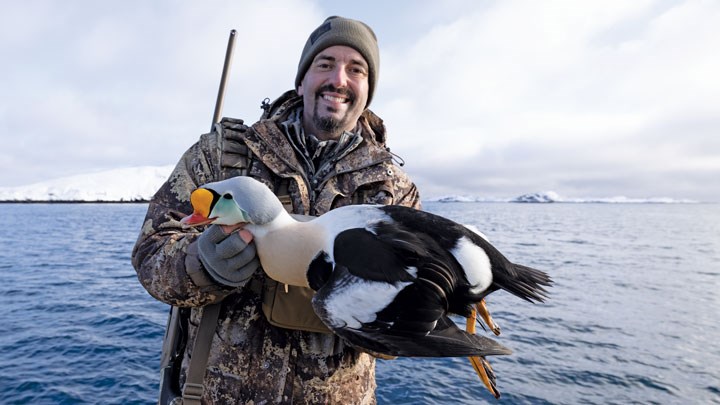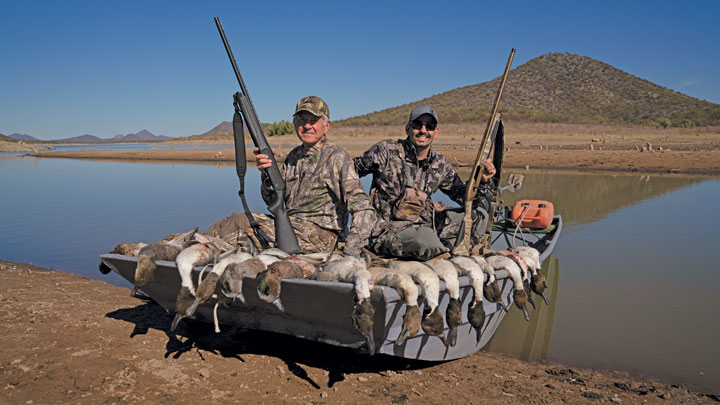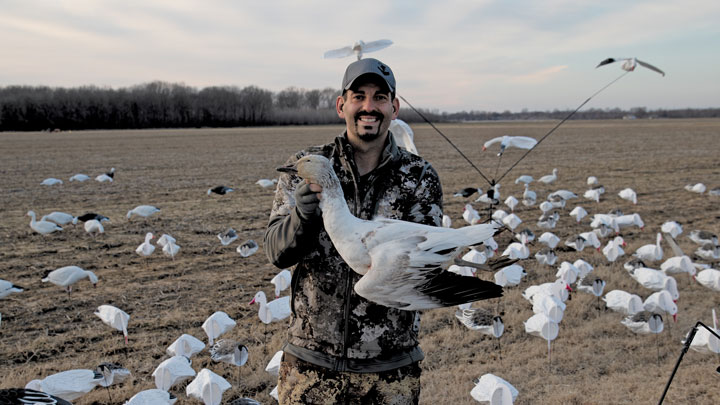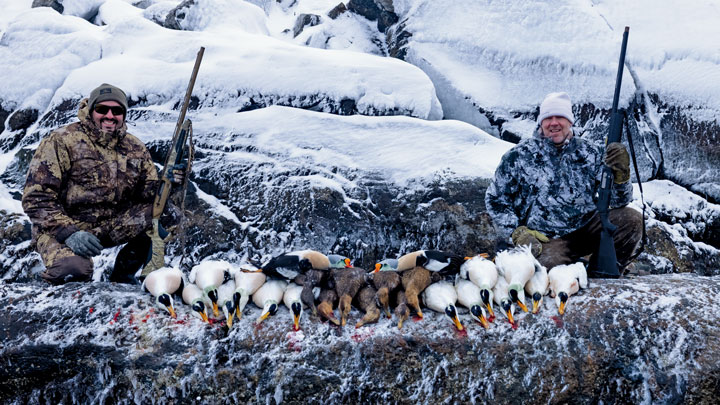
by Mathew Brost and Mark Peterson - Thursday, April 7, 2022

Above: Perhaps no waterfowl species is more ornately adorned than the male King Eider, a sea duck that proved to be the most challenging species in Mark Peterson’s season-long quest.
In February 2020, NRA Hunters’ Leadership Forum (HLF) member Mark Peterson had just completed the North American Upland Slam. His next adventure would be taking all 43 North American waterfowl species in a single season, but COVID-19 soon put his goal at risk. Friends and family encouraged him to wait until the next season, but he continued planning waterfowl hunts. His dedication and perseverance would become increasingly essential in a challenging new world.
It made the most sense for him to start in Canada, but Americans had zero access to the country due to the pandemic’s travel restrictions. Collaboration between Peterson and his company, Worldwide Trophy Adventures (WTA), resulted in hunts starting farther north in Cold Bay, Alaska. On Oct. 17, 2020, that’s where his quest to achieve a North American Waterfowl Slam began.
The First Birds
Bright sunshine reflected off decoys, causing birds to flare. The hunting was slow, but Peterson took several Cackling geese. Over the next few days, he took a beautiful Red-breasted merganser, then he and his father, Earl, each took three Harlequin. The next evening, Peterson enjoyed his favorite waterfowl for dinner—Brant—that he’d taken that afternoon. He went on to take Mallards, an Aleutian green-winged Teal and a mixed bag that included a drake Bufflehead and a Common Goldeneye, bringing his total to eight species. Then, with the wind at his back, two Greater Scaup screamed over his head. He missed them both and hoped those misses would not come back to haunt him.
Luck of the Draw
Peterson drew a North Dakota Tundra Swan permit and arrived there on Nov. 1. He dropped a pair of Common Mergansers before making a sneak on Ruddy Ducks to check No. 10 off the list that first morning. Just before shooting light ended, he dropped a drake Redhead. The next morning, he heard swan after swan leaving the lake as he broke ice with every step, wading through cattails. To his surprise, legal shooting light revealed four Tundra Swans remaining on the lake. He dropped one for No. 12 then took a Gadwell for No. 13.
After his required COVID test came back negative, he traveled to Kodiak Island with the primary goal of harvesting a Barrow’s Goldeneye. Several days of nasty weather made the hunting tough, but he took the species along with a Common Scoter and Surf Scoter.
A New Shotgun
With 16 species and plenty of good waterfowl dinners under his belt, Peterson anticipated his next hunt, not only for the opportunity to hunt sea ducks in Maine, but also to try out his new Browning Maxus II Wicked Wing 12-gauge semi-auto. He dropped a Common Eider and Long-tailed Duck then checked a White-winged Scoter off his list. The new-model Browning did its job, but Mother Nature wasn’t as accommodating. The weather turned, forcing him to improvise. He tried hunting a bay but spent more time untangling decoy strings than hunting. After three hours, the waves were too dangerous to navigate so he called it a day.
Before leaving Maine, Peterson took a Black Duck and a boat limit of Long-tailed ducks. He’d upped his total to 20 of the 43 species needed for his slam. Next up would be a reprieve from the weather with a trip to Sonora, Mexico.
From One Extreme to Another
Peterson arrived in Sonora on Dec. 6 to target a single species: the Fulvous Whistling Duck. He encountered the worst drought the region had experienced in a year. The ponds that weren’t dry had extremely low water levels. He improvised with makeshift blinds and jump-shooting. Those efforts paid off with a Pintail and Coot. The next day he used a simple dugout in the bank of a pond to break up his silhouette and took Nos. 23 and 24, a Green-winged teal and a Northern Shoveler. On day three, he again hid in a dugout, this time on the Sea of Cortez. He was treated to one the best waterfowl hunts he’d ever experienced. Two hours later, he had a limit of Brant and was done for the day.

That evening, Sonora’s drought ended with a steady downpour. The next day he took a mixed bag of Pintail, Gadwall and his second Black Duck of the season. The highlight was discovering his Gadwall was banded, making for his first banded duck. Unfortunately, the drought had pushed the Fulvous Whistling Ducks farther south.
A hunt in Arkansas with dad Earl was up next and made for Peterson’s first-ever traditional flooded-timber experience. He took a beautiful drake Ringneck, upping his total to 25 species. The duo also hunted ducks on a fish farm, each taking a Lesser Scaup before moving to hunt Specks over cut rice fields. On their way, Peterson detoured to a pond and took a Hooded Merganser, No. 27. With three hours of shooting light left, he waited on the rice field. A pair of Specks came in from behind him and No. 28 fell from the sky.
On Jan. 2, he headed to Oklahoma for a Sandhill Crane hunt. He quickly filled his daily limit of three then took a Canada Goose for No. 30. He joined a family of three generations of hunters the next morning and took No. 31, a Ross Goose.
Growing Concern
With 12 species left, he was confident he’d be able to get 11 of them. The one that worried him was the King Eider as the locations he’d planned to hunt were closed due to the pandemic. It was a long shot, but convincing Greenland to let him into the country might be his only option. In the meantime, he worked with WTA to plan trips targeting individual species.
He headed for a Canvasback hunt in southwest Georgia, setting up on a small island in thick brush on Seminole Lake. The first day was unsuccessful, but things soon changed for the better. Missing lunch to remain in the chest-high water situated behind two bamboo poles stuck in the sand, he was busy enjoying his Chex Mix snack when a group of Canvasback came screaming by him. He hastily shouldered his Browning and took the Canvasback with his third shot—No. 32.
Getting Creative
Next Peterson drove to Lake City, Fla., to hunt Wood Duck. He dropped one over a pond but had no dog to retrieve it. His cameraman, Justin, thought he could use the drone that had been recording footage with to get the duck to the bank. Peterson said, “I honestly never would have imagined I’d be without a dog or boat, trying to retrieve a Wood Duck with a drone.” The drone’s rotors made little waves in the water that pushed the duck toward the bank, delivering No. 33. That evening, he drove another 250 miles to Lake Okeechobee to hunt dabbling ducks.
He quickly had his limit of ducks, including a Black-bellied Whistling Duck. Just after shooting light the next morning, he dropped a Mottled Duck and later a Blue-winged teal for No. 36. The Fulvous Whistling Duck continued to elude him.
Peterson traveled to Rhode Island where he set up in a layout boat off the coast. Atlantic Brants were everywhere. Within 10 minutes, Mark had his two-Brant limit. No. 37 was in his boat and only six species remained. The next morning, he had No. 38 in the bag: a Greater Scaup.
He had one day left on the Atlantic coast. Canada wasn’t an option for King Eider and nobody had seen any Kings on Alaska’s coast. Only one possibility for a King Eider remained—Greenland, which wasn’t sounding promising. Fortunately, there had been two sightings of a young King Eider in the area. Peterson spent the entire day glassing but no luck. January 31 came and went, and with it went his last chance to hunt King Eider in the United States.
On Feb. 2 he traveled to Arkansas. He needed a Common Snow and Blue Snow to up his total to 40. He dropped all three on that trip. On the last evening, he reached out to his contacts in Greenland but was told there was little hope that the country would reopen anytime soon.

Crunch Time
With three species remaining, Sinaloa, Mexico, was his next destination. He took a rare Cinnamon Teal on his first morning. He glassed thousands of Black-bellied Whistling Ducks, but never spotted the Fulvous Whistling Duck, which continued to elude him. That species had moved farther south so he needed a new plan.
That night, WTA connected Peterson with an outfitter south of Sinaloa in Culiacán. After a short flight, he was in a blind. Black-bellied and Fulvous whistling ducks came in together. “That morning’s hunt was, without a doubt, the best day of hunting since the Waterfowl Slam started,” Peterson said. He took a mixed bag of Black-bellies, Fulvous, Pintail and a Blue-winged Teal. Only one species remained.
One Species and Nowhere to Hunt
The primary obstacle was getting Greenland’s government to approve entering the country during the lockdown. Fortunately, Greenland was pushing to grow tourism and draw more visitors—particularly hunters. Peterson saw an opportunity to get more hunters to travel there if he first could vet Greenland outfitters. WTA helped Peterson make his case, and the trip was a go.
Peterson purchased every Common Eider decoy he could find–all eight of them. On March 14, he and his friend Matt, WTA’s senior consultant, boarded a plane for Greenland. The next five days were spent quarantined in a hotel room. After taking another COVID test that came back negative, on day six they were allowed to go hunting.
Hunting A King
On March 20, Peterson improvised once more. No hunting boats were available to nonresidents, but bright yellow water taxis could be rented—not ideal for attracting waterfowl. As feared, the first groups of waterfowl they approached flew away from the yellow boat. Finally, a Common Eider held until they drifted within range, and Peterson made his shot.Videographer Justin had his drone along—the same drone that retrieved the Florida Wood Duck. There was nowhere to land it, so Peterson tried grabbing it out of the air. Just then, the taxi hit a wave and three of his fingers got caught in the drone’s blades. Blood was everywhere so he grabbed the first-aid kit. Can you guess what came within range while putting on Band-aids? Matt quickly got into shooting position and took the first King Eider of the trip. It wasn’t long before one flew in front of Peterson as his entire season came down to that moment.

Mark was on day No. 110 with one species remaining for his North American Waterfowl Slam. He shouldered his Browning, got his bead on the King and squeezed the trigger. Number 43 dropped into the water. With his goal reached, Peterson could take a deep breath—at least until he decided what his next big adventure would be, no doubt with his dad, Matt and the rest of the WTA crew along for the ride.
Editor’s Note
Those who want to watch NRA Hunters’ Leadership Forum member and WTA owner Mark Peterson accomplish his North American Waterfowl Slam can check out his many YouTube videos as every hunt was captured on film. Not only is Peterson the first to accomplish this feat in a single season, taking all 41 species that comprise the slam, but he stepped up the challenge by adding two additional species: the American coot and sandhill crane as these species are often considered other waterfowl.—Karen Mehall Phillips
Worldwide Trophy Adventures: Your Ultimate Outdoor Connection
As an NRA affinity partner, Mark Peterson and his company, Worldwide Trophy Adventures (WTA), work to make your hunting and fishing trips easier, safer and more productive—for free. As this NRA Hunters’ Leadership Forum (HLF) website has shared, whether you book directly with an outfitter or through WTA, your cost is the same. When WTA does the legwork for you, you increase your odds of success and are assured of being in a good location with a reputable outfitter that WTA has certified or endorsed. WTA consultants also provide tips on trip preparation and physical requirements and advice in dealing with your guide, gratuities and other details. To book your own adventure of a lifetime, click here.
Quick to support the NRA in fighting to save hunting’s future, Peterson and WTA are donating the adventure of a lifetime to the NRA HLF: a week-long Alaska bear hunt for four hunters and four non-hunters from May 26-June 1, 2023, aboard the noted Golden Eagle luxury yacht. The hunt will be auctioned at the annual NRA HLF dinner May 26 in conjunction with the NRA Annual Meetings and Exhibits in Houston, May 27-29.
E-mail your comments/questions about this site to:
[email protected]
Proudly supported by The NRA Foundation and Friends of NRA fundraising.
